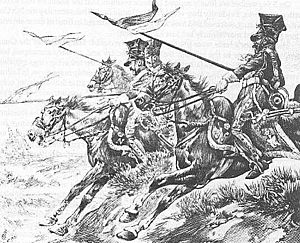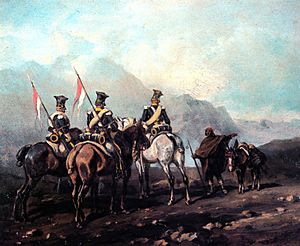Battle of Los Yébenes facts for kids
Quick facts for kids Battle of Los Yébenes |
|||||||
|---|---|---|---|---|---|---|---|
| Part of Peninsular War | |||||||
 Polish Vistula Lancers in charge |
|||||||
|
|||||||
| Belligerents | |||||||
| Commanders and leaders | |||||||
| Strength | |||||||
| 590 | 5,000 | ||||||
| Casualties and losses | |||||||
| 89 killed or captured | Unknown | ||||||
The Battle of Los Yébenes was a fight that happened on March 24, 1809. It was part of the Peninsular War, which was a big conflict in Spain and Portugal. In this battle, a small group of Polish Lancers (soldiers who use long spears called lances) fought against a much larger Spanish cavalry force. The battle took place near the Spanish village of Los Yébenes. Even though the Polish Lancers were greatly outnumbered, they managed to escape from the Spanish army.
Contents
What Led to the Battle of Los Yébenes?
General Valence's Polish Division was part of a larger French army. They left the city of Toledo on March 20, 1809. Their goal was to march southwest and take control of Andalusia, a region in southern Spain. On the evening of March 23, they stopped to rest in a town called Mora.
Why Los Yébenes Was a Bad Choice for a Camp
The Polish Lancers, about 591 men, could have stayed in a safer town nearby called Orgaz. But their leader, Colonel Jan Konopka, chose the village of Los Yébenes as their camp. The Poles had found it comfortable during earlier patrols.
However, Los Yébenes was a very difficult place to defend. One soldier, Kajetan Wojciechowski, wrote that the valley was dangerous for cavalry. The only way out was a narrow, winding path through the mountains. On one side were tall rocks, and on the other, a deep drop. This meant soldiers had no space to get ready for a fight or to retreat safely. It was like a trap.
Colonel Konopka might not have known that a large Spanish army was gathering nearby. The Polish soldiers were spread out in the village. Their wagons with supplies were also there. Guards were placed around the village, but they were not enough.
The Battle Unfolds
The morning of March 24 was very foggy. The Polish guards heard strange sounds. They told Colonel Konopka, but he told them not to worry. He thought the Spanish army was still far away, near the Guadiana river. He was wrong.
Hidden by the fog, a new Spanish army, led by Count de Cartaojal, was getting ready to attack. At seven in the morning, the Spanish forces attacked the Lancers, who had just woken up.
Polish Lancers Fight Back
The Polish soldiers from the 5th company immediately started fighting the Spanish. Meanwhile, the rest of the Polish regiment quickly tried to form up near the church in the village center. Suddenly, the fog lifted. The Poles saw many Spanish cavalry soldiers and two groups of cannons.
Colonel Konopka realized that the Spanish had many more soldiers. He gave the only possible order: retreat towards the main French army. The Polish squadrons quickly turned around and rushed towards Orgaz in a marching line. Colonel Konopka and Major Andrzej Ruttie led the way. The 5th company stayed behind to protect the others.
A Fierce Fight on the Narrow Road
Soon, the Lancers, led by Konopka, met two Spanish cavalry regiments. Konopka shouted, "Forward, boys!" The Polish soldiers at the front lowered their lances and charged fiercely. They attacked the Royal Carabineers, who were one of the best Spanish regiments. The Carabineers were blocking the narrow road, which had a steep drop on one side. They had no way to move forward or back.
It was a very tough fight. The Polish Lancers had an advantage with their long lances. The Carabineers, who used swords, were quickly defeated. In the chaotic fight, the Carabineers were trapped between the attacking Poles and other Spanish soldiers behind them. Some jumped into a rocky river, and others tried to climb the steep slopes. Those on the road were killed.
The Lancers' attack completely surprised the Spanish. They had been sure they would win. But now, seeing their front lines broken, they started to fall back. The Lancers kept pushing forward. Soon, they fought their way to a wider part of the road. There, they separated from the Spanish and galloped away.
Colonel Konopka, Major Ruttie, and a few Lancers reached Mora safely. This was where the main French forces were. Colonel Konopka thought his regiment was lost. However, the rest of the regiment, led by Captain Telesfor Kostanecki, fought their way through the Spanish lines. They took a longer route through Consuegra and arrived in Mora a few hours later.
When General Sebastiani arrived with more French soldiers, the Spanish commander Cartaojal had to retreat to Ciudad Real.
What Happened After the Battle?
The Polish Lancers lost many soldiers at Los Yébenes. Lieutenant Stanisław Moszyński was killed. Captains Jan Szulc and Kajetan Stokowski, Lieutenant Stawierski, and surgeon Jan Gryll were wounded and captured. The regiment lost 89 men between March 8 and April 15. About 42 of these were likely killed in the battle itself.
The Lost Banners
The regiment also lost all its supply wagons. With the wagons, they lost all four of their special banners. These banners were gifts from Napoleon's wife, Joséphine de Beauharnais. Losing the banners was a great shame for the Lancers. They felt they had to quickly earn back their honor. This defeat became known all over Spain. It was one of the few times the Spanish army truly hurt the Polish Lancers' reputation.
The Lancers soon got a chance to prove themselves.
- On March 27, 1809, at the Battle of Ciudad Real, they captured a bridge and defeated Spanish infantry.
- The next day, at the Battle of Santa Cruz de Mudela, the Lancers again crushed the same Spanish forces.
- On September 18, 1809, at the Battle of Ocaña, the mere sight of the "Lancers from Hell" made the same Royal Carabineers regiment leave the battlefield.
Colonel Konopka's Fate
In early May, Colonel Konopka left the regiment and went to France. This was likely for an investigation into the lost banners. He returned to the regiment after 15 months. Because the banners were lost, the regiment was not given new ones. One soldier wrote that the battle of Los Yébenes was "the end of our punishment for the standards lost."
Later, in 1811, the regiment became part of the regular French army. Colonel Konopka became an instructor. During the invasion of Russia in 1812, he led a new regiment. But in October 1812, he was captured by the Russians. He died in January 1815 due to his imprisonment.
The Mystery of the Lost Banners
A soldier named Wojciechowski later wrote about the lost banners. He learned that the banners were secretly hidden in a saddlebag in the Colonel's wagon. This wagon was left behind and captured by the Spanish. Losing the banners was a serious mistake because they were supposed to be kept safe behind the battle lines. Because of this, the regiment was not allowed to join the special Imperial Guard.
Count Cartaojal, the Spanish commander, reported that they captured 98 Polish soldiers, including three officers, and "a banner." Later, he added that "two more banners" were found on a Polish officer who died. This means the Spanish likely captured three of the four banners. The fourth banner was probably burned with the wagons.
Where Did the Banners Go?
It's not completely clear what happened to the three captured banners.
- Two of them were later displayed in the Royal Chapel of Saint Francis Cathedral in Seville.
- One banner was presented to the Spanish parliament in Cádiz. It was hung in a church but later disappeared.
- In 1889, a book mentioned the banner of the 1st squadron in Seville. It wrongly connected it to the Battle of Bailén.
- Today, only the banner of the 2nd Squadron remains in the Seville cathedral. The banner of the 1st Squadron was moved to the Musée de l'Armée in Paris around 1910.
The loss of the banners was a big deal for the Polish Lancers. But their bravery in later battles helped them regain their famous reputation.
See also


